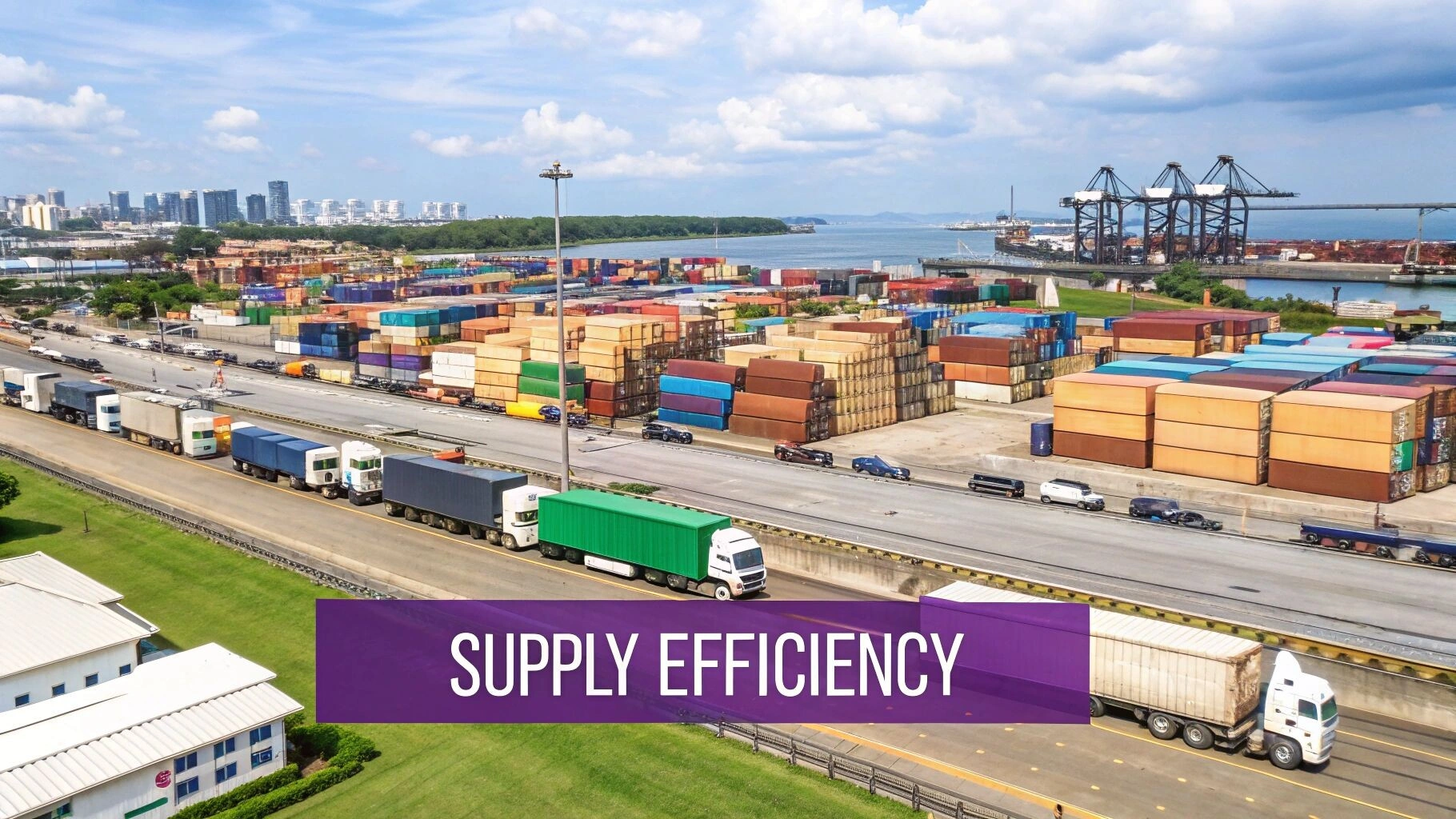9 High-Impact Cost Reduction Strategies for 2025
Discover 9 powerful cost reduction strategies for 2025. Unlock efficiency with AI, automation, and lean principles to transform your bottom line.

Simply cutting expenses is not enough. True financial resilience comes from intelligent, strategic cost reduction that enhances value rather than sacrificing it. Businesses that thrive are those that systematically identify and eliminate inefficiencies, leveraging powerful tools like AI Agents, Robotic Process Automation RPA, and seamless system integrations to build leaner, more agile operations. This approach forms a critical component of a company’s financial planning. For a deeper exploration into the foundational elements of strategic thinking that underpin such initiatives, consider reviewing broader strategic frameworks.
This article moves beyond generic advice to provide a comprehensive roundup of nine high-impact cost reduction strategies. We will explore practical, actionable methods, from Lean Manufacturing principles to advanced Automation and Supply Chain Optimisation, designed to deliver measurable results. Whether you aim to streamline workflows, reduce operational overheads, or future-proof your organisation against market volatility, these proven strategies offer a clear roadmap to sustainable profitability. We will delve into real-world examples, implementation tips, and the specific technologies that can transform your cost structure from a liability into a competitive advantage. Prepare to discover how to implement these changes effectively and drive significant bottom-line improvement.
1. Harness Lean Manufacturing Principles to Eliminate Waste
Lean manufacturing is a powerful system for minimising waste (Muda) and maximising value, a philosophy pioneered by Toyota that extends far beyond the factory floor. It forces organisations to analyse their processes from the customer’s viewpoint, relentlessly cutting any activity or resource that doesn’t add value they would willingly pay for. This focus on continuous improvement (Kaizen) creates hyper-efficient workflows, serving as a cornerstone for sustainable cost reduction strategies.

By visualising and optimising every step from production to delivery, companies can achieve dramatic results. For instance, Boeing reorganised its assembly lines using lean principles, reducing manufacturing time by 50 per cent. Similarly, Nike applied lean methods to its supply chain, cutting production costs by 20 per cent while improving delivery times.
Key Implementation Steps
To effectively implement lean, focus on a structured approach:
- Conduct a Value Stream Map: Begin by mapping a key process to visually identify bottlenecks, delays, and non-value-adding activities. This is the foundation for targeted improvement.
- Empower Your Team: Train all employees in lean principles. A culture of Kaizen is built from the ground up, where everyone is empowered to identify and eliminate waste.
- Implement 5S Methodology: Use the 5S system (Sort, Set in Order, Shine, Standardise, Sustain) to organise the physical and digital workspace. An organised environment is a prerequisite for efficiency.
- Start Small: Focus on one process or department at a time. Demonstrating success with a pilot project builds crucial momentum and buy-in for broader implementation.
2. Automation and Technology Integration
Strategic automation involves implementing digital technologies, robotics, and integrated systems to replace manual, repetitive processes. This approach is fundamental to modern cost reduction strategies, as it directly reduces labour costs, enhances operational efficiency, and minimises the financial impact of human error. By automating rule-based workflows, organisations can reallocate human capital to higher-value, strategic tasks, driving both innovation and savings.
The impact of this strategy is profound across various industries. For example, Amazon’s pioneering use of warehouse robotics has been reported to save the company up to $2.5 billion annually. Similarly, McDonald’s successfully deployed self-service kiosks, leading to a reported 15 per cent reduction in labour costs, while JP Morgan’s COIN system processed legal documents in seconds, saving an estimated 360,000 work hours per year.
The following graphic summarises these key data points, showcasing the tangible financial and operational gains achieved through automation.

These figures demonstrate how automation delivers not just incremental savings but transformative efficiency improvements, freeing up immense resources. Exploring the diverse benefits of business automation can reveal further opportunities for your organisation.
Key Implementation Steps
A successful automation initiative requires careful planning and a phased rollout:
- Identify High-Impact Tasks: Start by identifying repetitive, high-volume, and rule-based tasks. Areas like data entry, invoice processing, and customer service queries are prime candidates for initial automation.
- Calculate ROI Beforehand: Conduct a thorough cost-benefit analysis. Calculate the potential Return on Investment (ROI), considering software licensing, implementation costs, and ongoing maintenance against projected savings in labour and error reduction.
- Prioritise Employee Retraining: Proactively develop and fund retraining and upskilling programs. Shifting employees from manual tasks to roles that manage, maintain, or leverage automated systems is crucial for a smooth transition and retaining valuable talent.
- Implement in Phases: Avoid a “big bang” approach. Roll out automation solutions in manageable phases, starting with a pilot project to prove the concept, refine processes, and build organisational buy-in for wider adoption.
3. Supply Chain Optimisation
Supply chain optimisation is a comprehensive strategy for streamlining the entire network, from sourcing raw materials to delivering finished products. It involves a systematic analysis of every touchpoint, including procurement, inventory management, logistics, and distribution. The goal is to create a highly synchronised, responsive, and efficient flow of goods, services, and information, directly leading to powerful cost reduction strategies while maintaining, and often improving, quality and service levels.

This approach has been famously mastered by global giants. Walmart’s cross-docking system and real-time inventory tracking allow it to achieve legendary efficiency. Similarly, Zara’s agile “fast fashion” model enables it to move from design to retail in weeks, drastically cutting warehousing costs and markdowns. By rethinking the entire value chain, these organisations turn their supply chains into a primary competitive advantage.
Key Implementation Steps
To effectively optimise your supply chain, focus on these actionable measures:
- Implement Demand Forecasting Software: Utilise advanced analytics and AI-powered tools to predict customer demand with greater accuracy. This minimises overstocking and stockouts, reducing carrying costs and lost sales.
- Conduct Regular Supplier Audits: Systematically evaluate supplier performance based on cost, quality, reliability, and lead times. This ensures you partner with the most efficient and cost-effective suppliers available.
- Negotiate Volume Discounts and Favourable Terms: Leverage your purchasing power by consolidating orders to secure better pricing. Also, negotiate longer payment terms to improve cash flow.
- Optimise Logistics and Warehousing: Analyse your transportation routes and warehouse locations to minimise travel distances and times. Optimising logistics is paramount, and you can find proven tips to reduce shipping costs to boost your bottom line.
4. Implement Strategic Outsourcing and Offshoring
Strategic outsourcing involves delegating specific business functions to external service providers to leverage specialised expertise, reduce operational overheads, and sharpen focus on core competencies. Offshoring takes this a step further by relocating those functions to another country, often to capitalise on lower labour costs. This approach has evolved from a simple cost-cutting tactic into a powerful strategy for accessing global talent pools and driving innovation, making it a key component of modern cost reduction strategies.
This model allows organisations to convert fixed internal costs into variable external expenses, enhancing financial flexibility. For example, General Electric famously reduced operational costs by up to 40 per cent through its offshore operations. Similarly, IBM’s extensive global outsourcing initiatives have reportedly saved the company billions, demonstrating the immense scale and impact of a well-executed strategy.
Key Implementation Steps
A successful outsourcing or offshoring engagement requires careful planning and management:
- Start with Non-Core Functions: Begin by outsourcing non-critical tasks like IT support, data entry, or customer service. This minimises risk and allows your organisation to build experience with managing external partners.
- Establish Clear Service Level Agreements (SLAs): Define precise, measurable performance metrics, responsibilities, and expectations in a legally binding SLA. This document is crucial for accountability and ensuring quality.
- Maintain Regular Communication: Implement a structured communication plan with regular meetings and reporting. Consistent contact is vital for overcoming time zone differences and maintaining alignment.
- Prioritise Cultural Compatibility: When selecting a partner, consider cultural and linguistic alignment to ensure smooth collaboration. To maximise your outsourcing strategy’s impact, research the best countries for outsourcing that align with your business needs and cost objectives.
5. Embrace Energy Efficiency and Sustainability Initiatives
Integrating energy efficiency and sustainable practices is no longer just a corporate social responsibility talking point; it’s a powerful financial lever. This strategy centres on systematically reducing energy consumption and waste, which directly lowers utility overheads, mitigates regulatory risks, and strengthens brand reputation. By adopting green technologies and fostering a culture of conservation, organisations can unlock significant savings and build operational resilience, making it a critical component of modern cost reduction strategies.

The financial impact of sustainability is well-documented by industry leaders. For example, Google’s long-term investments in renewable energy and hyper-efficient data centres save the company over a billion dollars annually. Similarly, flooring manufacturer Interface Inc. famously reduced its energy consumption per unit of production by 96 per cent as part of its “Mission Zero” pledge, proving that environmental goals can drive profound economic benefits.
Key Implementation Steps
To effectively harness sustainability for cost savings, a measured approach is essential:
- Conduct a Professional Energy Audit: Begin by commissioning a comprehensive audit to identify key areas of energy waste across your facilities, from inefficient HVAC systems to outdated lighting. This data provides a clear roadmap for high-impact improvements.
- Invest in Smart Technology: Implement smart metering and IoT sensors to gain real-time visibility into energy usage. This allows for dynamic adjustments and pinpoints anomalies before they become costly problems.
- Empower Employees Through Training: Develop and roll out training programs that educate staff on conservation best practices. Simple behavioural changes, when adopted company-wide, can lead to substantial reductions in utility bills.
- Pursue Green Certifications: Aim for certifications like NABERS (National Australian Built Environment Rating System) or Green Star. The process itself drives efficiency improvements, and the certification enhances your company’s marketability and corporate image.
6. Workforce Optimization
Workforce optimisation involves the strategic management of human capital to align labour costs directly with productivity and business objectives. It moves beyond simple headcount reduction, focusing instead on ensuring the right people, with the right skills, are in the right roles at the right time. This sophisticated approach to cost reduction strategies uses data analytics, flexible work models, and targeted skill development to create a highly efficient and adaptable workforce that drives value without unnecessary overheads.
The impact of a well-executed strategy is significant. For example, Microsoft’s adoption of a flexible work policy reportedly reduced its real estate and office costs by 30 per cent. Similarly, Southwest Airlines famously uses a cross-training model where employees are skilled in multiple roles, improving operational efficiency by an estimated 25 per cent and minimising downtime during operational shifts.
Key Implementation Steps
To effectively optimise your workforce, a data-driven and employee-centric approach is vital:
- Use Workforce Analytics Tools: Implement HR analytics platforms to analyse data on performance, engagement, and skill gaps. This allows for informed decisions on staffing levels, training needs, and succession planning.
- Implement Flexible Scheduling: Offer flexible work arrangements like remote work, compressed work weeks, or flextime. This can boost employee morale and productivity while reducing physical office space costs.
- Provide Cross-Training Opportunities: Develop programs to train employees in multiple roles. This creates a more versatile team, improves coverage for absences, and enhances operational efficiency.
- Focus on Performance Metrics: Shift towards performance-based compensation structures that reward productivity and results. This aligns employee incentives with company goals, as seen with Salesforce, which boosted sales productivity by linking compensation to clear performance targets.
7. Embrace Radical Process Reengineering for Breakthrough Gains
Unlike continuous improvement, which refines existing workflows, business process reengineering (BPR) is a radical redesign strategy. It involves fundamentally rethinking and overhauling core processes to achieve dramatic improvements in critical measures like cost, quality, service, and speed. BPR challenges long-held assumptions and seeks to rebuild processes from the ground up, often using technology as a powerful enabler for innovation.
This approach is one of the most potent cost reduction strategies because it doesn’t just trim fat; it redefines the entire operational skeleton. For example, Ford Motor Company reengineered its accounts payable process, shifting from paying upon receipt of an invoice to paying upon receipt of goods. This simple change, enabled by a shared database, reduced its accounts payable department headcount by an astounding 75 per cent. Similarly, Hallmark slashed its product development cycle by 50 per cent by redesigning its team collaboration processes.
Key Implementation Steps
To execute a successful BPR initiative, a clean-slate perspective is essential:
- Target High-Impact Processes: Focus first on processes that are broken, cross-functional, and crucial to strategic goals, such as order fulfilment or customer onboarding. These offer the greatest potential for significant returns.
- Involve Employees in the Redesign: Assemble a cross-functional team of individuals who perform the work daily. Their insights are invaluable for identifying fundamental flaws and designing practical, innovative solutions.
- Leverage Technology as an Enabler: Use tools like workflow automation, AI, and integrated enterprise systems not just to computerise an old process, but to create entirely new, more efficient ways of working.
- Monitor Progress Relentlessly: Establish clear metrics (KPIs) before you begin. Continuously track performance against these benchmarks to validate improvements and ensure the new process delivers on its promise. Learn more with these business process reengineering steps from osher.com.au.
8. Adopt Strategic Cost Management for Sustainable Value
Strategic Cost Management moves beyond simple cost-cutting to a holistic approach that tightly aligns every financial decision with long-term business objectives. Instead of asking “How can we cut costs?”, it asks “How can we spend smarter to create more value?”. This philosophy treats cost management not as an isolated finance function but as a core component of competitive strategy, ensuring resources are allocated to activities that strengthen the company’s market position and drive sustainable growth. It’s a critical mindset shift from reactive budget trimming to proactive value creation.
This approach delivers powerful results by focusing on the “why” behind each expense. Procter & Gamble, for example, used strategic cost management to analyse its brand portfolio and supply chain, leading to a 200-basis-point increase in profit margins. Similarly, Caterpillar’s renowned value engineering program, a form of strategic cost management, has saved the company billions by redesigning products to reduce costs without sacrificing the quality customers expect.
Key Implementation Steps
To effectively integrate Strategic Cost Management, focus on a methodical, organisation-wide effort:
- Align Costs with Corporate Strategy: Begin by mapping your primary business strategies (e.g., market leadership, innovation, customer intimacy) and evaluate whether your major cost centres directly support these goals. Divest from or re-engineer activities that don’t align.
- Focus on Value Creation: Instead of across-the-board cuts, analyse which costs drive customer value and competitive advantage. Protect and invest in these areas while aggressively targeting costs that add little strategic value.
- Use Activity-Based Costing (ABC): Implement ABC to gain a true understanding of the costs of specific products, services, and activities. This detailed insight is crucial for making informed strategic decisions about where to invest or cut back.
- Involve Cross-Functional Teams: Create teams with members from finance, operations, marketing, and R&D. This collaborative approach ensures that cost decisions consider all strategic implications, preventing siloed thinking that can inadvertently harm other business units.
9. Implement Shared Services and Centralisation
Shared services and centralisation are strategic models for reorganising common business functions like finance, HR, and IT into a single, specialised unit. Instead of each department or business unit having its own siloed support staff, these functions are consolidated to serve the entire organisation. This eliminates redundant roles, standardises processes, and leverages economies of scale, making it a powerful cost reduction strategy for medium to large enterprises.
This approach drives significant efficiency gains and cost savings. For example, General Electric’s pioneering use of shared services reportedly saved the company over $1.5 billion by centralising its finance and accounting operations. Similarly, Procter & Gamble’s Global Business Services unit reduced overhead costs by a third while improving service quality across its international operations.
Key Implementation Steps
To successfully transition to a shared services model, a phased and structured approach is essential:
- Start with Transactional Processes: Begin by centralising high-volume, rule-based functions like accounts payable, payroll, or IT helpdesks. These processes are easier to standardise and provide a clear path to early wins.
- Establish Clear Service Level Agreements (SLAs): Define and agree upon performance metrics, response times, and quality standards with all business units. SLAs ensure accountability and maintain service quality.
- Invest in a Central Technology Platform: Implement robust systems, such as an ERP or a dedicated service management platform, to automate workflows, track requests, and provide a single source of truth.
- Manage Change Carefully: Centralisation is a significant cultural shift. Communicate the benefits transparently, provide thorough training, and manage stakeholder expectations to ensure a smooth transition and user adoption.
Cost Reduction Strategies Comparison Matrix
| Approach | Implementation Complexity | Resource Requirements | Expected Outcomes | Ideal Use Cases | Key Advantages |
|---|---|---|---|---|---|
| Lean Manufacturing | Moderate to High | Cultural change, training | Reduced waste, improved quality, faster lead times | Manufacturing with repetitive processes | Increases efficiency, enhances customer satisfaction |
| Automation and Technology Integration | High | High initial investment, technical expertise | Labor cost reduction, increased productivity, 24/7 operations | High-volume repetitive processes | Improves accuracy, reduces human error |
| Supply Chain Optimization | Moderate to High | Data analysis, supplier management | Lower procurement/transport costs, better inventory turnover | Complex supply chains with multiple suppliers | Enhances supply chain visibility, cost reduction |
| Outsourcing and Offshoring | Moderate | Vendor management, communication | Significant cost savings, access to expertise | Labor-intensive, standardizable processes | Scalability, risk transfer, cost reduction |
| Energy Efficiency and Sustainability | Moderate | Upfront investment in tech | Reduced energy costs, regulatory compliance | High energy consumption or manufacturing | Long-term savings, improved brand reputation |
| Workforce Optimization | Moderate | HR analytics, management | Lower labor costs, higher productivity | Service-oriented with variable demand | Improves employee satisfaction and retention |
| Process Reengineering | High | Significant investment, change management | Dramatic cost and time reductions | Outdated or inefficient core processes | Competitive advantage, improved quality |
| Strategic Cost Management | High | Extensive analysis, cultural change | Sustainable cost reductions, improved profitability | Large corporations with complex costs | Aligns costs with strategy, long-term focus |
| Shared Services and Centralization | Moderate to High | Technology platforms, change mgmt | Reduced admin costs, standardized processes | Large organizations with multiple units | Economies of scale, improved service quality |
From Strategy to Action: Building a Culture of Cost Efficiency
The journey through these nine comprehensive cost reduction strategies reveals a powerful truth: effective cost management is no longer about isolated cuts or temporary austerity measures. It is about a fundamental, strategic shift towards building a resilient, agile, and efficient enterprise. The strategies outlined, from lean manufacturing and supply chain optimisation to strategic cost management and shared services, are not mutually exclusive tactics. Instead, they are interconnected pillars that support a modern, cost-conscious organisational culture.
A common thread weaving through these powerful approaches is the transformative impact of technology. The era of purely manual process reengineering is over. Today, sustainable efficiency is driven by automation and intelligent systems. Robotic Process Automation (RPA) is the new engine for workforce optimisation, freeing human talent from repetitive tasks to focus on high-value strategic work. Artificial Intelligence (AI) now underpins sophisticated supply chain forecasting and energy management, turning data into predictive insights that preempt waste and inefficiency. Integrated systems act as the central nervous system of a cost-optimised organisation, eliminating data silos and creating a single source of truth for informed decision-making.
Key Takeaways for Immediate Action
To move from theory to tangible results, your focus must be on integration and cultural adoption. The most successful organisations don’t just implement a new tool; they embed a new mindset.
- Prioritise Integration Over Isolation: Avoid the pitfall of implementing these strategies in silos. For example, your supply chain optimisation efforts will be exponentially more effective when supported by an integrated ERP system and AI-powered demand forecasting, connecting directly to your lean manufacturing floor.
- Empower Your Teams: Cost reduction is not solely an executive mandate. Equip your operations, IT, and finance teams with the tools, training, and autonomy to identify and eliminate inefficiencies within their own workflows. A culture of cost ownership at every level is your greatest asset.
- Start with a Strategic Audit: Before investing in new technology or overhauling processes, conduct a thorough audit of your current operations. Identify the top three areas with the most significant manual effort, data redundancy, or resource waste. This focused approach ensures your initial efforts deliver the highest possible return on investment.
Ultimately, mastering these cost reduction strategies is about future-proofing your business. It’s about building an organisation that is not just lean, but also agile and intelligent, capable of adapting to market shifts and seizing new opportunities without being burdened by operational drag. This proactive stance on efficiency becomes a profound competitive advantage, driving not only profitability but also sustainable, long-term growth.
Ready to transform these strategies into measurable results? The expert team at Osher Digital specialises in designing and implementing bespoke business process automation and AI-driven solutions that turn your cost reduction goals into reality. Contact Osher Digital today to discover how we can help you build a more efficient, profitable, and future-ready enterprise.
Jump to a section
Ready to streamline your operations?
Get in touch for a free consultation to see how we can streamline your operations and increase your productivity.